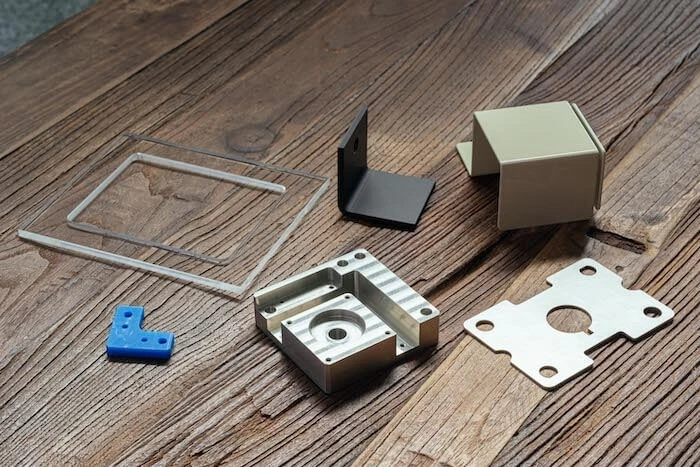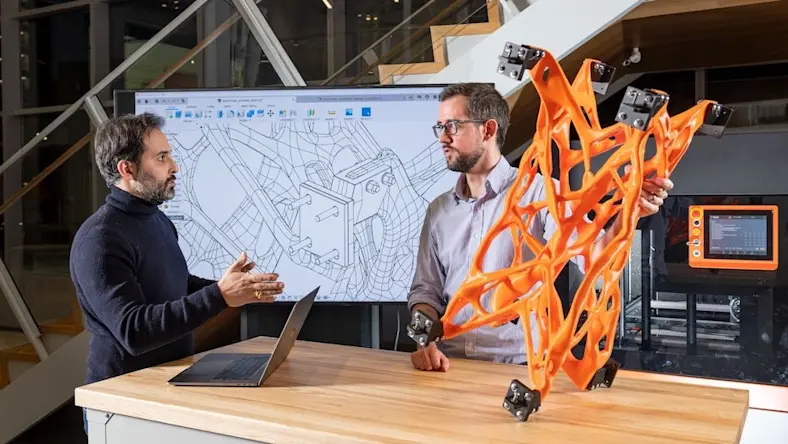& Construction

Integrated BIM tools, including Revit, AutoCAD, and Civil 3D
& Manufacturing

Professional CAD/CAM tools built on Inventor and AutoCAD
The word catalog might bring to mind an outdated brick-like book that companies like Sears mailed in the pre-Internet era (though, reportedly, catalogs may be making a comeback). But in global manufacturing, catalogs can go far, especially when combined with artificial intelligence (AI).
Forty years ago, Japanese company MISUMI began offering parts for manufacturing equipment, molds, inspection tools, and factory equipment through catalog sales. At the time, putting out an enormous variety of standardized parts, clearly described with set prices and delivery times, was a revelation. MISUMI drastically reduced the work time required to draw paper plans and generate estimates; it soon became the social infrastructure of the manufacturing industry.
MISUMI still increases productivity through catalog sales. The driving force behind its success is a unique order-made manufacturing process that offers 80 sextillion (80 billion trillion) product variations combined with a supply chain that can ship 200,000 orders a day. And while the concept of a catalog offering 80 sextillion product variations might sound fanciful, in fact, the current catalog covers only about half of customers’ needs.
“MISUMI applied its long years of R&D experience to set off in a new direction,” says Mitsunobu Yoshida, a senior corporate officer at MISUMI and president, ID (Industrial Digital) Manufacturing Business Company. “The ‘catalog’ concept had been refined, giving customers many product variations. The next step was creating a service that allowed customers to upload their own design data and receive a cost estimate and lead time. This concept, which ultimately became meviy, shifts the customer’s activity from choosing parts to actually creating them.”
Manufacturing accounts for 20% of Japan’s gross domestic product, and according to Yoshida, 270 products by Japanese companies hold a global share of more than 60%. Per the 2019 “White Paper on Manufacturing Industries,” from Japan’s Ministry of Economy, Trade, and Industry, that was twice the number of products from the United States and five times that of China. “It shows Japan remains highly competitive on the world stage,” Yoshida says. “However, with numbers of workers dwindling, staff shortages and labor law reforms are squeezing small- and medium-size businesses, accelerating closures in Japan’s manufacturing industry.”
Manufacturing in Japan is gaining productivity through digitalization, with CAD/CAE design automation, automated manufacturing using robots, and the growth of e-commerce sales channels. “When you look at procurement, however, paper and faxes still dominate the landscape,” Yoshida says. “A recent independent study revealed that 98% of procurement departments are still using fax for ordering. Current procurement methods have become a bottleneck holding back productivity gains throughout the entire manufacturing industry.”
Yoshida gives the example of a machine with 1,500 parts: If it takes 30 minutes to create a drawing for each part, that’s 750 hours of work. It then takes a combined 25 hours to approve and fax the drawings. Then, it takes one week for the estimate and another two weeks until delivery. So the entire procurement process can take 1,000 hours—or 125 days. “It goes without saying, but this is a huge drain on time,” Yoshida says.
The meviy system launched in 2016, sparking a digital revolution in machine-parts procurement. Yoshida says two key innovations led to its success: AI-generated estimates for customers and the benefits that digital craftsmanship brings to the order-made production pipeline.
For the first innovation, AI-generated estimates, Yoshida says: “Previously, an engineer had to manually examine an order and determine the work hours required to machine and drill holes in a part. Now, the customer uploads 3D design data, which is then used by the AI to calculate costs and delivery times in a matter of seconds.”
The meviy interface immediately reflects any changes to materials or finishing processes onto the cost. Smart functions identify other machining requirements, such as whether a hole is a simple opening or threaded for screws. Changes such as tolerance settings can be made within meviy. Production requirements are also examined to ensure that an order can be machined correctly.
Another issue is looming. “We’re facing a crisis of passing technical know-how on to the next generation of engineers,” Yoshida says. “Providing documentation, videos, and manuals only helps so much. We’ve found in companies that use meviy that the service is helping designers improve their work. Especially now with the coronavirus pandemic, junior staff cannot work alongside their mentors, so the help meviy provides is invaluable.”
The meviy system’s second innovation is introducing digital craftsmanship to the order-made production pipeline. “Because the system generates the machining program automatically and sends it to the shop floor, almost no human involvement is required from the time the design data is uploaded until the part is produced at the factory,” Yoshida says. “This means a part can be machined and shipped on the next day it is ordered. I don’t know if there is anywhere else in the world that can offer next-day shipping in this way.”
Two services offered through meviy are rapid prototyping for product design and supply of factory-automation mechanical parts, such as metal components and machining plates. All of the system’s components were in place by 2019; now, meviy has more than 55,000 users. Yoshida says more than 5.3 million CAD models have been uploaded by many industries, from automotive, machinery, and electronics manufacturers to chemical and medical equipment suppliers.
Using meviy eliminates 2D drawings and estimates, streamlining the manufacturing process. Taking the earlier example of procurement for machinery with 1,500 parts, the 1,000 hours formerly required is reduced to 80 hours: a 92% reduction and a drastic improvement in labor productivity.
Users can register for meviy for free and begin using it right away. Various native 3D CAD formats are supported, including Autodesk Inventor and intermediate formats such as STEP. Users can employ 3D CAD in their work, regardless of the type or size of the parts they need.
Feedback for the service has largely been positive, reporting dramatic reductions in work and in turnaround time. “We are hearing that the time required for a single development cycle now can be used for two or three cycles, leading to improved quality,” Yoshida says. “In many cases, users are reporting that removing the paperwork has reduced overhead and improved productivity.”
MISUMI surveyed small and medium enterprises in the summer of 2020. “With the pandemic and ongoing trade friction between the US and China, only 20% of companies have realized growth in the past two years,” Yoshida says. “The biggest difference between companies that grew and those that did not lay in how well they adopted digital tools such as Zoom and Teams.”
Yoshida says that in addition to using time effectively, it is equally important to do high-value work. Digital transformation and automation are difficult to achieve and take time to realize. “We need to change our way of thinking, as well,” Yoshida says. “For now, meviy is a tool we can use to contribute to productivity gains in manufacturing. We intend to expand the service toward more applications while also improving its UI/UX. Looking past 2021, we also plan to begin providing services to customers overseas, so keep an eye out for that, too.”
Yasuo Matsunaka is a keyboard player, space-movie devotee, editor of Design & Make with Autodesk Japan, and international content manager for APAC and Japan at Autodesk.
Executive insights
Emerging Tech
PD&M








